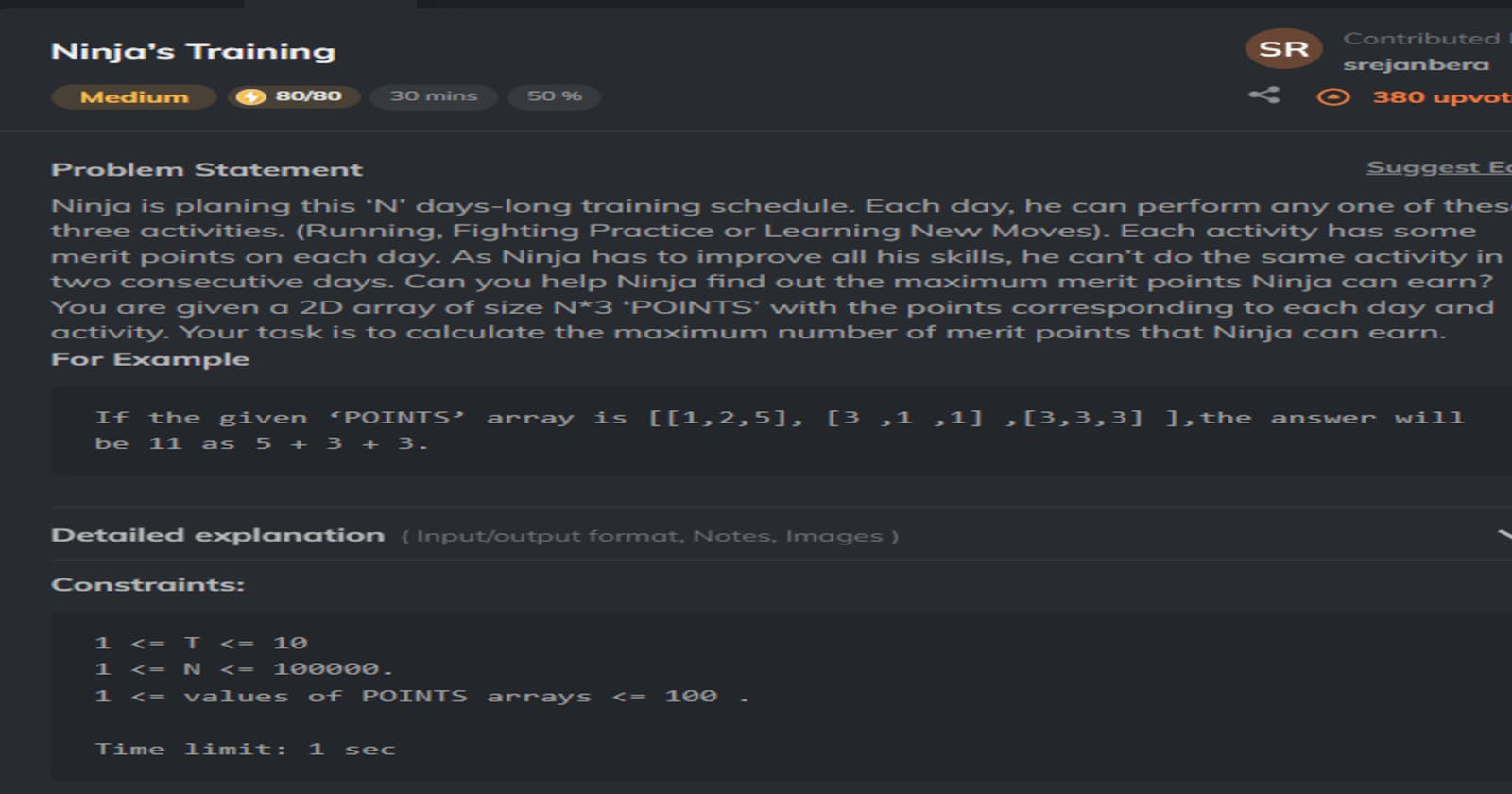Daily Dose of DSA - Day 21
Ninja's Training using RecursiveDP(Top-Bottom)(TC:O(3*4*n)&SC:O(4*n)+O(n)call stack)&Using Iterative DP(Bottom-Up)(TC:O(3*4*n)&SC:O(4*n) O(1)(sp.opt)
Question Link: https://www.codingninjas.com/studio/problems/ninja-s-training_3621003?leftPanelTab=0
Using Recursive DP(Top-Bottom):
The function
recis defined to find the maximum score up to a specificindexgiven that the task ati+1index was done last.The function uses a memoization technique with the help of the
dparray. Thedparray stores the maximum scores calculated for each index, allowing us to reuse the results and avoid redundant recursive calls.The base case of the recursion is when
indexis 0. In this case, the function calculates the maximum score for the first index by considering all possible tasks (0, 1, and 2) except the one done at the next index (last). The maximum score is stored in thedparray at the corresponding index and returned.If the maximum score for the current
indexhas already been calculated and stored in thedparray, the function directly returns the stored value, eliminating the need for further recursive calls.Inside the function, a variable
maxiis initialized to keep track of the maximum score obtained up to the current index.The function iterates over the three possible tasks (0, 1, and 2) excluding the task done at the
index+1position (last).For each task, it calculates the score by adding the points obtained for the task at the current
index(points[index][i]) with the maximum score obtained recursively for the previous index (rec(index-1, i, points, dp)).The function updates
maxiby taking the maximum value betweenmaxiand the calculated score. This step ensures thatmaxistores the maximum score obtained by considering different tasks at the current index.The function stores
maxiin thedparray at the corresponding index (dp[index]) for future use.Finally, the function returns the maximum score obtained at the last index (
dp[n-1]), wherenis the total number of indices in the given input.
int rec(int index , int last, vector<vector<int>> &points,vector<int>&dp)
{
if(index==0) //base case
{
int maxi2 = 0;
for(int i=0;i<=2;i++)
{
if(i!=last)
maxi2 = max(maxi2,points[0][i]);
}
dp[index] = maxi2;
return dp[index];
}
if(dp[index]!=-1) return dp[index]; //To avoid redundancies
int maxi = 0 ;
for(int i=0;i<=2;i++)
{
if(i!=last)
{
int score = points[index][i] + rec(index-1,i,points,dp);
maxi = max(maxi,score);
}
}
dp[index]= maxi;
return dp[index];
}
Using Iterative DP (Bottom-Up):
The
ninjaTrainingfunction receives the number of rowsnand the 2D vectorpointsrepresenting the points scored for different tasks at each index.It initializes a 2D dynamic programming array
dpof sizenby 4, wheredp[i][j]represents the maximum score up to indexiwith the task at indexi+1done last.The initial values of the
dparray are set based on the points scored in the first row of thepointsvector. For example,dp[0][0]is set to the maximum value betweenpoints[0][1]andpoints[0][2],dp[0][1]is set to the maximum value betweenpoints[0][0]andpoints[0][2],dp[0][2]is set to the maximum value betweenpoints[0][0]andpoints[0][1], anddp[0][3]is set to the maximum value amongpoints[0][0],points[0][1], andpoints[0][2].The function iterates from index
1ton-1, representing the remaining rows of thepointsvector.For each index and each possible last task, represented by the variable
last(ranging from0to3), the maximum score is calculated. The maximum score is determined by iterating over the three possible tasks (0,1, and2) and adding the points obtained for the task at the current index (points[index][i]) with the maximum score obtained previously for the task at indexi(dp[index-1][i]). The maximum of these scores is stored in themaxivariable.The
dp[index][last]value is updated with the maximum score obtained for the currentlast.After calculating the maximum scores for all possible last tasks at the current index, the function moves on to the next index.
Finally, the function returns
dp[n-1][3], which represents the maximum score considering any task done last at the last index.
#include<bits/stdc++.h>
using namespace std;
int ninjaTraining(int n, vector<vector<int>>&points)
{
vector<vector<int>> dp(n,vector<int>(4,0));
dp[0][0] = max(points[0][1],points[0][2]);
dp[0][1] = max(points[0][0],points[0][2]);
dp[0][2] = max(points[0][0],points[0][1]);
dp[0][3] = max({points[0][0],points[0][1],points[0][2]});
for(int index=1;index<n;index++)
{
for(int last=0;last<4;last++)
{
dp[index][last] = 0;
int maxi = 0;
for(int i=0;i<3;i++)
{
if(i!=last)
{
int score = points[index][i] + dp[index-1][i];
maxi = max(maxi,score);
}
}
dp[index][last] = maxi;
}
}
return dp[n-1][3];
}
Using Sp.Optimization in Iterative DP:
The
ninjaTrainingfunction receives the number of rowsnand the 2D vectorpointsrepresenting the points scored for different tasks at each index.It initializes a vector
dpof size 4, wheredp[i]represents the maximum score considering the task done at indexi+1last.The initial values of the
dpvector are set based on the points scored in the first row of thepointsvector. For example,dp[0]is set to the maximum value betweenpoints[0][1]andpoints[0][2],dp[1]is set to the maximum value betweenpoints[0][0]andpoints[0][2],dp[2]is set to the maximum value betweenpoints[0][0]andpoints[0][1], anddp[3]is set to the maximum value amongpoints[0][0],points[0][1], andpoints[0][2].The function iterates from index 1 to n-1, representing the remaining rows of the
pointsvector.For each index, a temporary vector
tempis created to store the updated maximum scores.For each possible last task, represented by the variable
last(ranging from 0 to 3), the maximum score is calculated. The maximum score is determined by iterating over the three possible tasks (0, 1, and 2) and adding the points obtained for the task at the current index (points[index][i]) with the maximum score obtained previously for the task at indexi(dp[i]). The maximum of these scores is stored in themaxivariable.The value of
temp[last]is updated with the maximum score obtained for the currentlast.After calculating the maximum scores for all possible last tasks at the current index, the
dpvector is updated by assigningtempto it. This ensures that the maximum scores for the next iteration are calculated correctly based on the updated values.Finally, the function returns
dp[3], which represents the maximum score considering any task done last at the last index.
#include <bits/stdc++.h>
using namespace std;
int ninjaTraining(int n, vector<vector<int>>& points)
{
vector<int> dp(4, 0);
dp[0] = max(points[0][1], points[0][2]);
dp[1] = max(points[0][0], points[0][2]);
dp[2] = max(points[0][0], points[0][1]);
dp[3] = max({ points[0][0], points[0][1], points[0][2] });
for (int index = 1; index < n; index++)
{
vector<int> temp(4, 0);
for (int last = 0; last < 4; last++)
{
int maxi = 0;
for (int i = 0; i < 3; i++)
{
if (i != last)
{
int score = points[index][i] + dp[i];
maxi = max(maxi, score);
}
}
temp[last] = maxi;
}
dp = temp;
}
return dp[3];
}
